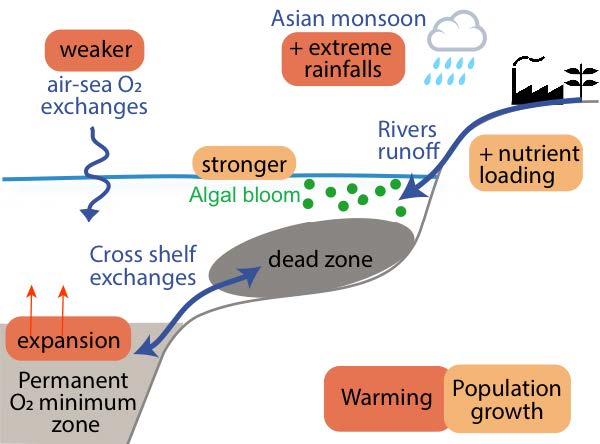Resplandy receives NSF CAREER Award to study the formation and future of Pacific and Indian Ocean dead zones
Laure Resplandy, assistant professor of geosciences and the High Meadows Environmental Institute (HMEI), received a five-year, $654,000 CAREER Award from the National Science Foundation to examine the complexity of factors that lead to the formation and expansion of oxygen-depleted regions, or “dead zones,” in the Indian and Pacific Oceans.
The world’s oceans are experiencing a devastating loss of oxygen, but the tropical Indian and Pacific Oceans are particularly vulnerable due to vast naturally occurring low-oxygen regions known as oxygen minimum zones (OMZs). These OMZs can expand due to human activity and trigger coastal dead zones with near-zero oxygen levels that suffocate marine ecosystems and devastate local fisheries and economies. Larger OMZs also would produce more of the potent greenhouse gas nitrous oxide and limit the ocean’s ability to absorb carbon already in the atmosphere.
Resplandy will work to develop a high-resolution ocean model that examines the physical, chemical and biological dynamics that produce OMZs and coastal dead zones, as well as how natural climatic variations and human activity could change them. Her model would for the first time allow scientists to assess the risk of OMZ and coastal dead zone formation based on natural climatic processes and human activity such as agricultural runoff and fossil fuel emissions. The project builds on preliminary work Resplandy conducted through her HMEI Climate and Energy Challenge project, “Risk of Permanent Coastal Dead Zones in the Tropical Indian Ocean.”


Resplandy also aims to evaluate the significant disparities between the latest Earth system models in projecting how OMZs and dead zones will evolve in the future. She plans to conduct a comprehensive analysis at the scale of the Indo-Pacific basin that connects OMZs to ventilation pathways and biogeochemical feedbacks, as well as key processes that have been largely overlooked such as human-driven aerosol deposition. This work could provide valuable insights for the next generation of Earth system models, which would be key to future Assessment Reports from the United Nations Intergovernmental Panel on Climate Change.
The CAREER award also supports the development of hands-on educational activities related to climate change and mitigation for local middle-school teachers and students. The Resplandy group will bring climate modeling concepts into the classroom to help teachers and students explore the effects of human activities on the climate, as well as present thought-provoking mitigation strategies such as a “cyclist planet” in which people rely on non-emitting transportation like bicycles.
“Climate projections are widely publicized by the media, yet few people know what climate models are, how scientists get these forecasts, or how the Earth’s temperature would change if everybody stopped driving their cars,” Resplandy said.
She hopes to share the activities on a peer-reviewed web platform and eventually expand them to the high-school level.




